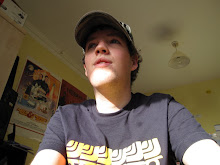The mine shaft is around 30 minutes drive from my home in Plymouth so I left at around 10pm to arrive at the location at 10 30pm when the dusk light will have dissapeared reveiling the full extent of the stars above.
I arrived and parked my car on the farm access road and made my way up the hill to the disused tower to set my equipment up on the South facing side, facing North. As always, setting up the equipment was difficult with only torch light to help me so I had to be careful not to move things too far from where I was working as to not forget about them and lose them.
I decided to shoot my sample image as always and here it is below:
Photo Factfile
Shutter Speed: 4 minutes
Aperture: f4.0
ISO: 1600

The image shows that the standard period of time will be fine for exposing the full image stack, while I also used the sample image to check focusing and composition which I have changed slightly in the following image, show with the same settings, but just to check the composition was acceptable:

I was happy with this composition so I moved on to start the 8 minute exposure and then follow it with up to 20 4 minute exposures which wouldgive me some long star trails in the sky above:

Unfortunately around 20 minutes in, a quad bike made it's way straight through the image, so essentially meant I had to start over after seeing how this problem affected the Haytor images I produced. So I decided to continue with the 4 minute exposures for around 45 minutes, until i noticed a cloud drifting over from Plymouth towards the stars I was shooting, which was guaranteed to ruin the photograph. I took steps to try to complete my shoot by 12:30am as I predicted the cloud would take this long to approach.
I started by upping the ISO number to 200 instead of 100 and also shooting my 8 minute foreground exposure before I ran out of time!
Eventually the cloud made it's way over the composition and I was forced to stop shooting for the night, but I did manage to get enough photographs to work with so I was pleased I hadn't wasted 3 hours out on the freezing cold moorland.
Anyway below is a stacked image featuring all the photographs shot after the quad bike came through:

It is again, well composed but lacks any punch so I need to put it into photoshop and see if I can bring some more colour and kick out of the image through use of the different adjustment masks.
Photoshop
This section looks at how I edited the final image above into something with much more depth and colour rather than just the ambient lighting in the background, so here is how I did it all :)
Curves
I again used the Curves adjustment to increase contrast within the image and bring out the deep blue in the sky as well as bring out details in the building, all these changes gave the photograph more depth and clarity than before:

Hue/Saturation
I used this adjustment to knock out some of the Red in the photograph, as the ambient light took on a different tone than previously in other photo shoots. So I went ahead and reduced the saturation of the Red channel to -60 reducing the incredible colour cast on the whole image:

Again I did some changes with the Blue channel and increased the saturation in the blues, although this wasn't required as much, due to the changes in Contrast which I made earlier:

Final Image
Below is the final image! the result of the editing above which is clearly very different to my initial stacked image from earlier.
I am very happy with it's appearance since I have edited the image as the stars now stand out but still sit behind the silhouette of the old pumping station, so they aren't too prominent, they appear about the same as the building.
I really like how the shape of the building adds mystery to the photograph and how there are no lights in the building, clearly showing that it is lonely and derelict in the mass expanse of the moorland around us.
The star trails behind the building show how the structure stands through time without any change, even the 'slouch' in the chimney will probably remain for hundreds of years to come before it finally falls down. But my image does lead the viewer to think about time and how many photographs don't capture it... if you would like to know more about this, take a look at my blog entry about Time :)
The composition also follws in line with the previous image of Hound Tor where the foreground subject features on the right, with the star trails able to fill the other three corners of the image. I am aware of the continuity but I think it is important for my photographs to follow this rule because then they will portray a much stronger message.







































